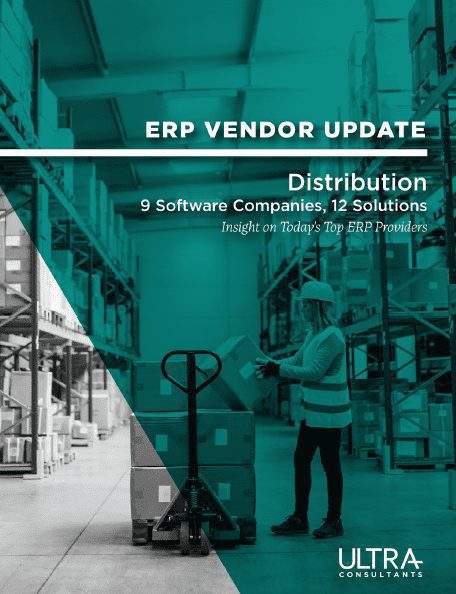Distributors are challenged like never before: Supply chain networks remain exceptionally complex and unpredictable, competition is tougher every day, and customer expectations are escalating. It’s critically important to do everything that can be done to cut costs, increase revenue and boost profitability.
How can your organization get more efficient? The answer: By driving change in virtually every function. To do these things, you need the right ERP solution. But what are the top ERP systems for distribution and which is right for your company?
That’s a difficult question. Because every company is different. Because no company handles any phase of operations the same way. Because business processes are built around the unique requirements of each organization.
Start by asking a different set of questions: What new capabilities does your organization need and want? What problems are you trying to solve? What do you want your core processes to look like? How can new tools enable your organization’s digital transformation?

ERP Vendor Update: Distribution
The ERP Vendor Update offers a close-up look at 10 of today’s top distribution software solutions.
Top ERP Systems for Distribution
In today’s fast-paced and competitive business landscape, distributors face numerous challenges, from managing inventory and streamlining operations to optimizing customer experiences. To stay ahead of the game, many distributors are turning to Enterprise Resource Planning (ERP) software—an innovative solution designed to revolutionize their operations.
From enhanced inventory management and streamlined operations to powerful analytics and improved customer satisfaction, ERP empowers distributors to overcome challenges and drive growth. If you’re a distributor looking for a game-changer in your industry, investing in an ERP system might just be the catalyst you need to take your business to new heights.

Overview of the 10 Top ERP Vendors
1. Acumatica
 Acumatica offers a cloud solution designed for distribution. Acumatica focuses on companies with revenues that range between $20 million and $200 million, with some existing customers that have significantly higher revenues. The number of employees at companies that are good fits for Acumatica is around 200.
Acumatica offers a cloud solution designed for distribution. Acumatica focuses on companies with revenues that range between $20 million and $200 million, with some existing customers that have significantly higher revenues. The number of employees at companies that are good fits for Acumatica is around 200.
Acumatica’s customers are extremely loyal – it claims a 95% retention rate. And most customers that leave are due to acquisitions. Acumatica does not price on a user license or revenue basis – it prices based on transaction volume, which is unique to the industry. It does have flexibility, however, to do user-based pricing if a customer insists on it.
Key Features
Acumatica provides a complete suite of distribution applications to boost sales, automate warehouse operations, optimize inventory and streamline purchasing.
- Sales order management – Optimize sales order entry and fulfillment. Split orders across multiple warehouses, allocate inventory, verify credit limits, issue replenishment orders, accept returns, and more.
- Warehouse management – Streamline warehouse operations and transactions to reduce errors, automate processes, and increase productivity.
- Inventory management – Simplify your inventory processes with flexible item management, quality traceability, and robust replenishment to balance supply and demand. Optimize stocking levels to avoid rush orders and stock-out situations with increased inventory turns and lower carrying costs.
- Requisition management – Organize and simplify complex distribution processes involving multiple products and suppliers. Optimize the way you gather requests, obtain bids, create quotes, approve quotes, manage purchases, and fulfill orders for internal or customer needs.
2. Aptean
 Aptean Distribution ERP customers typically are mid-market consumer goods importers and distributors with revenues ranging from $10 million to $300 million and/or 10 to 250 concurrent users. While available both as on-premises and SaaS single-tenant solutions, over the last three to four years the SaaS has been the primary option.
Aptean Distribution ERP customers typically are mid-market consumer goods importers and distributors with revenues ranging from $10 million to $300 million and/or 10 to 250 concurrent users. While available both as on-premises and SaaS single-tenant solutions, over the last three to four years the SaaS has been the primary option.
Aptean Distribution ERP is cloud-enabled software designed to handle everything consumer goods importers and distributors need to efficiently run and grow their business without costly and complicated customizations or integrations. It enables enterprise-wide visibility and agility, improved operational processes, performance and profitability.
Key Features
The platform is built with industry-specific functionality to fulfill core functions out-of-the-box, such as embedded EDI, chargeback management and forecasting tools, while ensuring the entire business is using real-time data to streamline and optimize their full supply chain.
- Warehouse management – Improve management of inventory, including receiving, picking and put-away of goods.
- Transportation and logistics – Shipping tools including route management, dynamic routing, BOLS (bill of lading) and packing slips allow consumer goods importers and distributors to bring a new level of organization and oversight to your operations.
- Supply chain management – Streamline and optimize the supply chain with EDI, chargeback management, direct-to-consumer shipping, and purchasing and import management.
3. Epicor
 With Prophet 21, Epicor provides wholesale distribution customers with an option that supports all durable goods distributors with support for sub-verticals within distribution. Epicor Prophet 21 is a cloud solution, with what’s called “dedicated tenant.” Customers share the network infrastructure and the application, but each client has a dedicated database.
With Prophet 21, Epicor provides wholesale distribution customers with an option that supports all durable goods distributors with support for sub-verticals within distribution. Epicor Prophet 21 is a cloud solution, with what’s called “dedicated tenant.” Customers share the network infrastructure and the application, but each client has a dedicated database.
One of Epicor Prophet 21’s strengths as a platform is that it provides both software and service. It has professional services and support teams dedicated to Prophet 21. They work closely with customers to learn their unique requirements. Through their extensibility tool set, Epicor allows users to define their unique data fields, use rules to define business logic, and integrate through full API access across the product.
Key Features
- Customer Relationship Management—CRM tools allow you to access information quickly and efficiently so you can streamline your day-to-day processes while improving customer service.
- Inventory Management—multiple dynamic inventory replenishment methods give you the flexibility to lower carrying costs, minimize excess or obsolete inventory, improve cash flow, and increase customer service levels.
- Warehouse Management System—WMS brings a new level of accuracy to all warehouse processes, including receiving, cross-docking, put-away, adjustments, picking, cycle counting, and inventory operations.
- Purchasing—whether you have one warehouse or dozens, Prophet 21 distribution software centralizes the purchasing process so you can optimize buying power and inventory levels.
4. Infor CloudSuite
 CloudSuite Distribution is a cloud-based, multi-tenant ERP solution purpose-built for wholesale distributors. This solution is backed up by 30-plus years of distribution industry experience. And this experience is manifested in its implementation accelerators that help businesses get up and running quickly with pre-configured distribution business processes and data models, user-defined home pages and distribution-specific training.
CloudSuite Distribution is a cloud-based, multi-tenant ERP solution purpose-built for wholesale distributors. This solution is backed up by 30-plus years of distribution industry experience. And this experience is manifested in its implementation accelerators that help businesses get up and running quickly with pre-configured distribution business processes and data models, user-defined home pages and distribution-specific training.
CloudSuite Distribution is built specifically for the needs of small- to medium-size wholesale distributors. You can optimize every facet of your operations from sales, omni-channel engagement, inventory and warehousing, to financials, value-add services and more.
Key Features
CloudSuite Distribution delivers industry-specific capabilities without extensive customizations or integrations by combining the cloud platform built on infrastructure services from Amazon Web Services (AWS) and OS.
- Supply chain management – Eliminate uncertainty and creates greater control over margins by improving supply chain visibility, increasing forecasting accuracy, and simplifying transparent communication with suppliers.
- Customer management – Centralize critical data, insights, and historical knowledge in one platform to equip employees with the expertise to solve complex customer demands.
- Inventory management – Streamline inventory management with advanced statistical forecasting and stock recommendations.
5. Microsoft Dynamics 365 Business Central
 Business Central is an ERP solution that is well suited for small and medium-sized companies. The software is designed to allow customers who have outgrown an entry-level ERP or home-grown solution from both a process and software perspective.
Business Central is an ERP solution that is well suited for small and medium-sized companies. The software is designed to allow customers who have outgrown an entry-level ERP or home-grown solution from both a process and software perspective.
Business Central also has one of the more straight-forward pricing models, making it easier to understand the cost of ownership. Business Central is not purchased directly from Microsoft. Instead, customers go through a reseller that usually is contracted to support the implementation of the software.
Key Features
On average, a Business Central Customer use two to five third-party apps to supplement the functionality of their initial implementation of the product. Many of the apps are developed to directly support the sub-verticals for various industries, including distribution.
- Supply chain optimization – Improve your supply chain with vendor management, purchasing, e-commerce with Shopify, order fulfillment, and returns.
- Warehouse management – Full batch and serial item support, receiving capabilities, multiple picking strategies, material handling traceability, simple cross docking.
- Transportation management – Identify vendor and routing solutions for inbound and outbound orders.
- Inventory management – Replenish inventory based on actuals, demand, and availability using AI-powered sales and inventory forecasting.
Ready to start your digital transformation journey?

6. Oracle Cloud
 Oracle Cloud is a single-tenant solution built in such a way that all the modules can operate independently, integrate seamlessly or plug-and-play with best-in-class solutions. Its functionality is appropriate for pure distributors, 3PL operations, retailers and manufacturers with heavy distribution requirements.
Oracle Cloud is a single-tenant solution built in such a way that all the modules can operate independently, integrate seamlessly or plug-and-play with best-in-class solutions. Its functionality is appropriate for pure distributors, 3PL operations, retailers and manufacturers with heavy distribution requirements.
Deep integrations between applications, as well as a common data model, common workflow engine, and a consistent user interface ensure that data is not trapped in silos.
Key Features
With a complete SaaS suite of applications built with AI and machine learning across all business functions, you get the latest advances in the best technology.
- Customer management – Automate the entire process from order capture, settlement, and post-sales care.
- Supply chain management – Get better visibility into upstream supply both internally and with strategic suppliers and contract manufacturers. Get early warnings to mismatched expectations and leverage available supplier capacity in your supply plans.
- Transportation management – Consolidate and execute transportation orders from multiple sources and eliminate inefficient and redundant settlement procedures.
- Warehouse/Inventory management – Leverage end-to-end inventory management, from manufacturer to distribution center and from store to consumer.
7. Oracle NetSuite
 NetSuite is built as a single database solution that has evolved through enrichment of the core functionality, not through acquisition of complementary software. The single database allows NetSuite to offer a simpler pricing model where you purchase the full functionality of the product.
NetSuite is built as a single database solution that has evolved through enrichment of the core functionality, not through acquisition of complementary software. The single database allows NetSuite to offer a simpler pricing model where you purchase the full functionality of the product.
NetSuite’s competitive advantages are its speed to implementation and ability to easily find pre-developed customizations through SuiteApp.com. Its cloud structure and ease of configuration make it a good solution for the distribution company that does not have a deep IT bench for either implementation or ongoing support.
Key Features
- Inventory management – Optimize the use of your inventory, reduce handling cost, optimize cash flow, and deliver products to your customers when and where they want them. Centrally manage inventory across multiple locations/selling channels.
- Transportation management – Improve pick, pack and ship process with zone and wave picking while prioritizing picking by carrier pick up time.
- Customer management – Access real-time customer data such as preferences, transactions and interactions to enable them to provide consistent service experiences across touchpoints.
- Warehouse management – Improve pick, pack and ship process with zone and wave picking while prioritizing picking by carrier pick up time.
8. Sage X3
![]() Sage X3 focuses on the manufacturing and distribution industries, and particularly companies with the “multis.” Any company with the complexity of being a multi-national, multi-language, multi-currency operation, or has multiple entities is an excellent fit for the Sage X3 solution.
Sage X3 focuses on the manufacturing and distribution industries, and particularly companies with the “multis.” Any company with the complexity of being a multi-national, multi-language, multi-currency operation, or has multiple entities is an excellent fit for the Sage X3 solution.
The ideal company size for Sage X3 are companies with around $30 million in revenue or higher, and have at least 50 employees. Companies with international supply chain complexity are a particularly good fit, such as furniture distributors managing the flow of inventory from manufacturing locations oversees (or having a vendor manage it but have access to their ERP system) and then handling distribution from warehouses in the United States or Canada.
Key Features
Sage X3 streamlines your core processes – from manufacturing to distribution and financial management to business services – while adapting to your industries best practices.
- Supply chain management – Optimize purchasing decisions and margins and manage supplier quality and performance.
- Inventory management – Fully integrated distribution functionalities with real-time monitoring and inventory optimization.
- Procurement – Centralize procurement processes, enabling procurement managers to manage supplier relationships, track purchasing activities, and negotiate better deals.
9. SAP Business One
 SAP Business One is the small- to mid-market solution. The ideal distributor size for SAP Business One is between $20 million and $250 million in revenue (with flexibility to go higher or lower), and 50 to 100 office workers and 15 to 75 warehouse workers.
SAP Business One is the small- to mid-market solution. The ideal distributor size for SAP Business One is between $20 million and $250 million in revenue (with flexibility to go higher or lower), and 50 to 100 office workers and 15 to 75 warehouse workers.
SAP Business One focuses on a few sub-verticals within distribution, including durable goods, food and electrical, with most of their customers being B2B companies. SAP Business One provides its customers with a scalable solution to grow as they grow. It gives them access to data and the ability to perform data analytics.
Key Features
SAP is investing in SAP Business One to bring new functionality to the solution, which it does using quarterly patch updates or upgrades that occur approximately every 18 months.
- Supply chain planning – Improve real-time data analysis and enable better collaboration across departments and companies with demand management and insights, response and supply planning, sales, inventory, and operations planning.
- Procurement – Manage global supply risk and protect profitability with cost recovery and rebates, buy-and-deliver services, invoice and payables management, and procurement analytics.
- Service and solutions – Connect service teams with the right expertise and tools at the right time, provide value-added services and empower agents to increase productivity and responsiveness.
10. SAP S4 Hana
 SAP S4 Hana has broad functionality that covers most industries and types of companies. However, it is typically geared for companies that are in the upper-mid-market or larger. Within the distribution marketplace, SAP’s largest market share is in healthcare/pharmaceuticals, where it supports the majority of the large distribution companies. They also have a strong presence in food service distribution, industrial product distribution and technology distribution.
SAP S4 Hana has broad functionality that covers most industries and types of companies. However, it is typically geared for companies that are in the upper-mid-market or larger. Within the distribution marketplace, SAP’s largest market share is in healthcare/pharmaceuticals, where it supports the majority of the large distribution companies. They also have a strong presence in food service distribution, industrial product distribution and technology distribution.
SAP has been focusing on distribution starting in the late 1990s. Since 2004, it has employed a global team of experts working with distribution customers to make sure the software and best practices it incorporates into its technologies meet the needs of this market.
Key Features
- Procurement – Manage the procure-to-pay process efficiently while accessing real-time insight at every stage.
- Supplier management – Build a strong supplier network with a transparent overview of your suppliers. You can approve the most reliable vendors and get the right mix to serve business needs while reducing risk.
- Inventory management – See real-time inventory and track the status of inbound and outbound deliveries to avoid stockouts.
Are you ready to see what an ERP consultant can do for your organization?
Call or set up a free 30 minute consultation with one of our ERP experts today!
Conclusion
While implementing a modern ERP might seem like a daunting task, the benefits it brings far outweigh the initial challenges. Streamlined operations, enhanced customer experience, real-time insights, and scalability are just a few reasons why distributors should consider embracing ERP solutions. Remember, it’s not just about staying competitive; it’s about unlocking efficiency and setting yourself up for success.
At Ultra, our careful and thorough methodology provides an experienced framework so that manufacturers like you can find the right food manufacturing ERP software that suits your specific needs, streamlines operations and helps you achieve your business goals. The best ERP systems for food manufacturing for your business will depend on your specific needs, so it typically makes sense to partner with an expert ERP consultant who can not only save you time but save you money as you work to discover the best ERP system for your food manufacturing company.
When you’re ready for that first conversation, we’re right here to help with ERP selection, implementation and value realization—for an ERP project that yields results.






